Analyzing the Probability of Acquiring Cloud-Free Imagery in China with AVHRR Cloud Mask Data
Abstract
:1. Introduction
2. Data and Methods
2.1. Study Area
2.2. AVHRR Cloud Mask
2.3. Data Processing
2.4. Methods
2.4.1. Statistics for the PACI in China
2.4.2. Calculating the Availability of Acquiring Cloud-Free Imagery by Sensors with Various Revisit Intervals
2.4.3. Validation of the Results
3. Results
3.1. The PACI in China
3.2. Interannual Variation of PACI
3.3. The Number of Days to Acquire Cloud-Free Imagery Monthly with Different Revisit Frequencies
3.4. Validation
4. Discussion
4.1. The PACI in China
4.2. Annual Variation of PACI
4.3. The Number of Days to Acquire Cloud-Free Imagery Per Month with Different Revisit Frequencies
5. Conclusions
- (1)
- The PACI varied among months and regions in China, which was consistent with the spatiotemporal characteristics of the regional climate. The overall national performance of the PACI was best in November. For all of China, the PACI gradually increased from southeast to northwest.
- (2)
- As the climate changes, the PACI in China changes. The PACI increased significantly throughout the nation and in most regions. The highest increase in all regions throughout the entire multiannual period occurred in NC.
- (3)
- As the sensor revisit interval increased, the number of days to acquire cloud-free imagery monthly decreased and the decline rate decreased. The results are valuable for choosing the appropriate revisit frequency of optical remote sensors and estimating the availability of composite images.
Author Contributions
Funding
Institutional Review Board Statement
Informed Consent Statement
Conflicts of Interest
References
- Zhang, B. Current status and future prospects of remote sensing. Bull. Chin. Acad. Sci. 2017, 32, 774–784. [Google Scholar] [CrossRef]
- Deng, W.; Zhang, X.; Luo, J.; Peng, Y. South China Sea Environment Monitoring Using Remote Sensing Techniques. J. Coast. Res. 2020, 95, 29–33. [Google Scholar] [CrossRef]
- Wang, J.; Xiao, X.; Qin, Y.; Dong, J.; Zhang, G.; Kou, W.; Jin, C.; Zhou, Y.; Zhang, Y. Mapping paddy rice planting area in wheat-rice double-cropped areas through integration of Landsat-8 OLI, MODIS, and PALSAR images. Sci. Rep. 2015, 5, 10088. [Google Scholar] [CrossRef] [PubMed] [Green Version]
- Liu, P. A Survey of Remote-Sensing Big Data. Available online: https://www.frontiersin.org/articles/10.3389/fenvs.2015.00045/full (accessed on 3 February 2021).
- Marshall, G.J.; Dowdeswell, J.A.; Rees, W.G. The spatial and temporal effect of cloud cover on the acquisition of high quality Landsat imagery in the European Arctic sector. Remote Sens. Environ. 1994, 50, 149–160. [Google Scholar] [CrossRef]
- Sano, E.E.; Ferreira, L.G.; Asner, G.P.; Steinke, E.T. Spatial and temporal probabilities of obtaining cloud-free Landsat images over the Brazilian tropical savanna. Int. J. Remote Sens. 2007, 28, 2739–2752. [Google Scholar] [CrossRef]
- Zhu, Z.; Woodcock, C.E. Automated cloud, cloud shadow, and snow detection in multitemporal Landsat data: An algorithm designed specifically for monitoring land cover change. Remote Sens. Environ. 2014, 152, 217–234. [Google Scholar] [CrossRef]
- Whitcraft, A.K.; Vermote, E.F.; Becker-Reshef, I.; Justice, C.O. Cloud cover throughout the agricultural growing season: Impacts on passive optical earth observations. Remote Sens. Environ. 2015, 156, 438–447. [Google Scholar] [CrossRef]
- Norris, J.R.; Allen, R.J.; Evan, A.T.; Zelinka, M.D.; O’Dell, C.W.; Klein, S.A. Evidence for climate change in the satellite cloud record. Nature 2016, 536, 72–75. [Google Scholar] [CrossRef] [Green Version]
- Sanchez-Lorenzo, A.; Enriquez-Alonso, A.; Calbo, J.; Gonzalez, J.A.; Wild, M.; Folini, D.; Norris, J.R.; Vicente-Serrano, S.M. Fewer clouds in the Mediterranean: Consistency of observations and climate simulations. Sci. Rep. 2017, 7, 41475. [Google Scholar] [CrossRef]
- Armitage, R.P.; Alberto Ramirez, F.; Mark Danson, F.; Ogunbadewa, E.Y. Probability of cloud-free observation conditions across Great Britain estimated using MODIS cloud mask. Remote Sens. Lett. 2013, 4, 427–435. [Google Scholar] [CrossRef]
- Liu, L.; Xiang, D.; Dong, X.; Zhou, Z. Improvement of the Drought Monitoring Model Based on the Cloud Parameters Method and Remote Sensing Data. In Proceedings of the First International Workshop on Knowledge Discovery and Data Mining (WKDD 2008), Adelaide, Australia, 23–24 January 2008; pp. 293–296. [Google Scholar]
- Ju, J.; Roy, D.P. The availability of cloud-free Landsat ETM+ data over the conterminous United States and globally. Remote Sens. Environ. 2008, 112, 1196–1211. [Google Scholar] [CrossRef]
- Mao, K.; Yuan, Z.; Zuo, Z.; Xu, T.; Shen, X.; Gao, C. Changes in Global Cloud Cover Based on Remote Sensing Data from 2003 to 2012. Chin. Geogr. Sci. 2019, 29, 306–315. [Google Scholar] [CrossRef] [Green Version]
- Zhou, F.; Zhang, A. Methodology for estimating availability of cloud-free image composites: A case study for southern Canada. Int. J. Appl. Earth Obs. Geoinf. 2013, 21, 17–31. [Google Scholar] [CrossRef]
- Roy, D.P.; Lewis, P.; Schaaf, C.; Devadiga, S.; Boschetti, L. The Global Impact of Clouds on the Production of MODIS Bidirectional Reflectance Model-Based Composites for Terrestrial Monitoring. IEEE Geosci. Remote Sens. Lett. 2006, 3, 452–456. [Google Scholar] [CrossRef] [Green Version]
- Asner, G.P. Cloud cover in Landsat observations of the Brazilian Amazon. Int. J. Remote Sens. 2010, 22, 3855–3862. [Google Scholar] [CrossRef]
- Laborde, H.; Douzal, V.; Ruiz Piña, H.A.; Morand, S.; Cornu, J.-F. Landsat-8 cloud-free observations in wet tropical areas: A case study in South East Asia. Remote Sens. Lett. 2017, 8, 537–546. [Google Scholar] [CrossRef]
- Xiao, C.; Li, P.; Feng, Z.; Wu, X. Spatio-temporal differences in cloud cover of Landsat-8 OLI observations across China during 2013–2016. J. Geogr. Sci. 2018, 28, 429–444. [Google Scholar] [CrossRef] [Green Version]
- Li, P.; Feng, Z.; Xiao, C. Acquisition probability differences in cloud coverage of the available Landsat observations over mainland Southeast Asia from 1986 to 2015. Int. J. Digit. Earth 2017, 11, 437–450. [Google Scholar] [CrossRef]
- Naoyuki, F.; Yasumasa, H.; Yoshio, A.; Eriko, I.; Yoshiyuki, K.; Hideki, S.; Izumi, N. Spatial and Temporal Analysis of Probabilities for Acquiring Cloud-free Optical Sensor Images Using MODIS Cloud Mask Products 2000–2008 in Southeast Asia. J. For. Plan. 2014, 19, 43–51. [Google Scholar] [CrossRef]
- Wu, X.; Sullivan, J.T.; Heidinger, A.K. Operational calibration of the Advanced Very High Resolution Radiometer (AVHRR) visible and near-infrared channels. Can. J. Remote Sens. 2014, 36, 602–616. [Google Scholar] [CrossRef]
- Thomas, S.M.; Heidinger, A.K.; Pavolonis, M.J. Comparison of NOAA’s operational AVHRR-derived cloud amount to other satellite-derived cloud climatologies. J. Clim. 2004, 17, 4805–4822. [Google Scholar] [CrossRef]
- Qin, D.; Ding, Y.; Mu, M. Climate and Environmental Change in China: 1951–2012; Springer: Berlin, Germany, 2015. [Google Scholar]
- Guo, B.; Zhang, J.; Meng, X.; Xu, T.; Song, Y. Long-term spatio-temporal precipitation variations in China with precipitation surface interpolated by ANUSPLIN. Sci. Rep. 2020, 10, 81. [Google Scholar] [CrossRef] [PubMed]
- Zhai, P.; Sun, A.; Ren, F.; Liu, X.; Gao, B.; Zhang, Q. Changes of Climate Extremes in China. In Weather and Climate Extremes; Springer: Dordrecht, The Netherlands, 1999; pp. 203–218. [Google Scholar]
- Zhang, M.; An, J.; Zhang, J.; Yu, D.; Wang, J.; Lv, X. Enhanced Delaunay Triangulation Sea Ice Tracking Algorithm with Combining Feature Tracking and Pattern Matching. Remote Sens. 2020, 12, 581. [Google Scholar] [CrossRef] [Green Version]
- Shriner, J.F., Jr.; Mitchell, G.E.; Bilpuch, E.G. Significance levels of linear correlation coefficients. Nucl. Instrum. Methods Phys. Res. 1987, 254, 139–145. [Google Scholar] [CrossRef]
- Liu, H.; Zhu, W.; Yi, S.; Li, W.; Chen, L. Climate analysis of the cloud over China. Acta Meteorol. Sin. 2003, 61, 466–473. [Google Scholar] [CrossRef]
- Xia, X. Variability and trend of diurnal temperature range in China and their relationship to total cloud cover and sunshine duration. Ann. Geophys. 2013, 31, 795–804. [Google Scholar] [CrossRef] [Green Version]
- Frenken, K. Irrigation in Southern and Eastern Asia in Figures: AQUASTAT Survey-2011. Available online: http://www.fao.org/3/i2809e/i2809e.pdf (accessed on 3 February 2021).
- Fu, C.; He, J.; Jiang, Z.; Xu, Z.; Guan, Z. Regional Climate Studies of China; Springer Science & Business Media: Berlin, Germany, 2008. [Google Scholar]
- Li, Y.; Yu, R.; Xu, Y.; Zhang, X. Spatial distribution and seasonal variation of cloud over China based on ISCCP data and surface observations. J. Meteorol. Soc. Jpn. 2004, 82, 761–773. [Google Scholar] [CrossRef] [Green Version]
- Feng, X.; Liu, C.; Fan, G.; Liu, X.; Feng, C. Climatology and Structures of Southwest Vortices in the NCEP Climate Forecast System Reanalysis. J. Clim. 2016, 29, 7675–7701. [Google Scholar] [CrossRef]
- Gu, Z.; Duan, X.; Liu, B.; Hu, J.; He, J. The spatial distribution and temporal variation of rainfall erosivity in the Yunnan Plateau, Southwest China: 1960–2012. Catena 2016, 145, 291–300. [Google Scholar] [CrossRef]
- Shi, Y.; Shen, Y.; Kang, E.; Li, D.; Ding, Y.; Zhang, G.; Hu, R. Recent and Future Climate Change in Northwest China. Clim. Chang. 2006, 80, 379–393. [Google Scholar] [CrossRef]
- Yang, Y.; Zhao, C.; Fan, H. Spatiotemporal distributions of cloud properties over China based on Himawari-8 advanced Himawari imager data. Atmos. Res. 2020, 240, 104927. [Google Scholar] [CrossRef]
- Wu, W.; Wang, S. Tendency Change of Cloud Cover over Northern China and Its Relation with Regional Climate. Plateau Meteorol. 2011, 30, 651–658. [Google Scholar]
- Stowe, L.L.; Davis, P.A.; McClain, E.P. Scientific basis and initial evaluation of the CLAVR-1 global clear/cloud classification algorithm for the Advanced Very High Resolution Radiometer. J. Atmos. Ocean. Technol. 1999, 16, 656–681. [Google Scholar] [CrossRef]
- Ren, G.; Ding, Y.; Zhao, Z.; Zheng, J.; Wu, T.; Tang, G.; Xu, Y. Recent progress in studies of climate change in China. Adv. Atmos. Sci. 2012, 29, 958–977. [Google Scholar] [CrossRef]
- Xu, Z.; Tang, Y.; Connor, T.; Li, D.; Li, Y.; Liu, J. Climate variability and trends at a national scale. Sci. Rep. 2017, 7, 3258. [Google Scholar] [CrossRef] [PubMed]
- Zong, X.-M.; Pu-Ca, W.; Xiang-Ao, X. Variability and long-term trend of total cloud cover in China derived from ISCCP, ERA-40, CRU3, and ground station datasets. Atmos. Ocean. Sci. Lett. 2013, 6, 133–137. [Google Scholar] [CrossRef]
- Ding, S.; Zhao, C.; Shi, G.; Wu, C. Analysis of global total cloud amount variation over the past 20 years. Q. J. Appl. Meteorol. 2005, 16, 670–677. [Google Scholar]
- Wang, D.; Xie, Q.; Du, Y.; Wang, W.; Chen, J. The 1997–1998 warm event in the South China Sea. Chin. Sci. Bull. 2002, 47, 1221–1227. [Google Scholar] [CrossRef]
- Wang, S.; Guo, L.; He, B.; lyu, Y.; Li, T. The stability of Qinghai-Tibet Plateau ecosystem to climate change. Phys. Chem. Earth 2020, 115, 102827. [Google Scholar] [CrossRef]
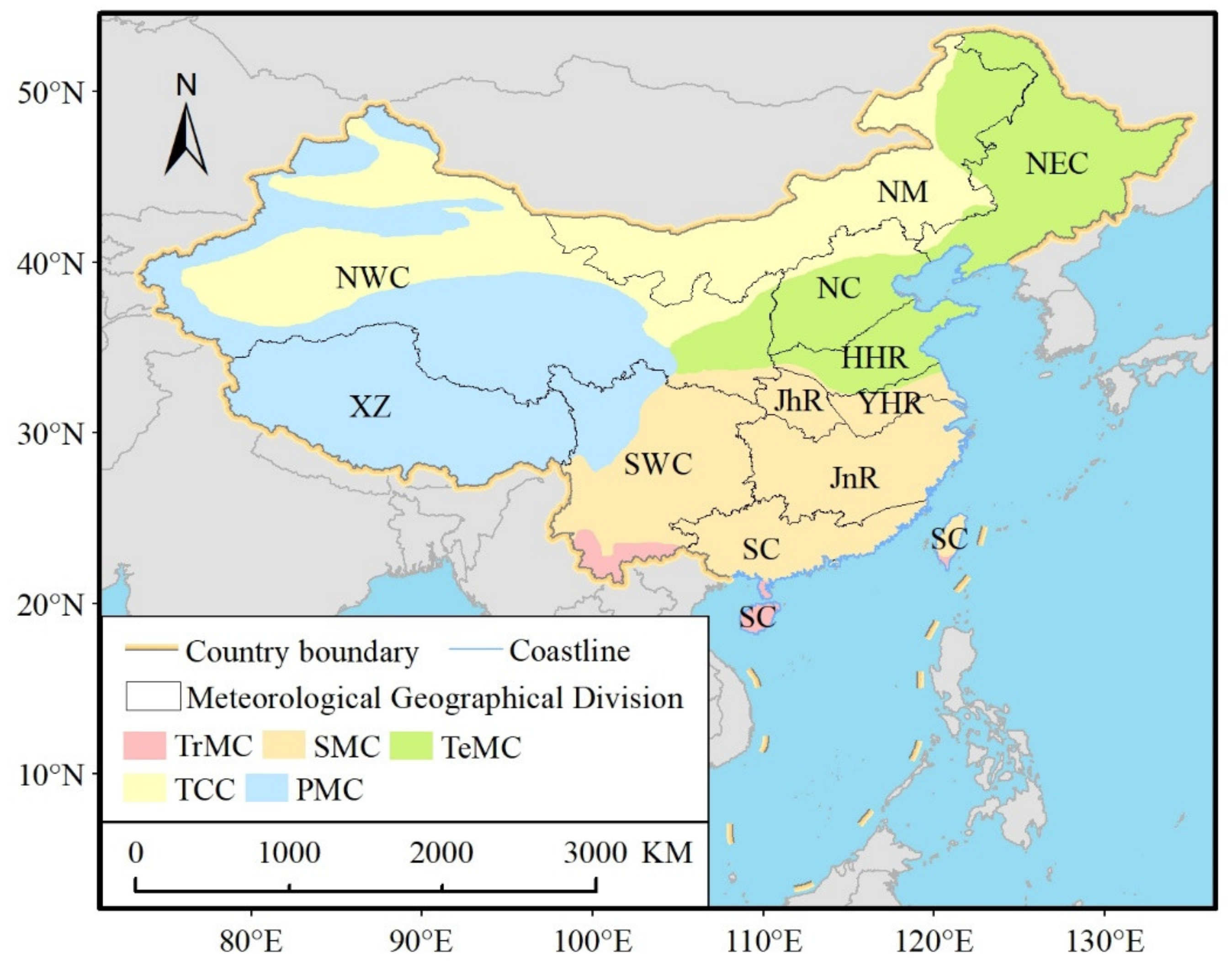
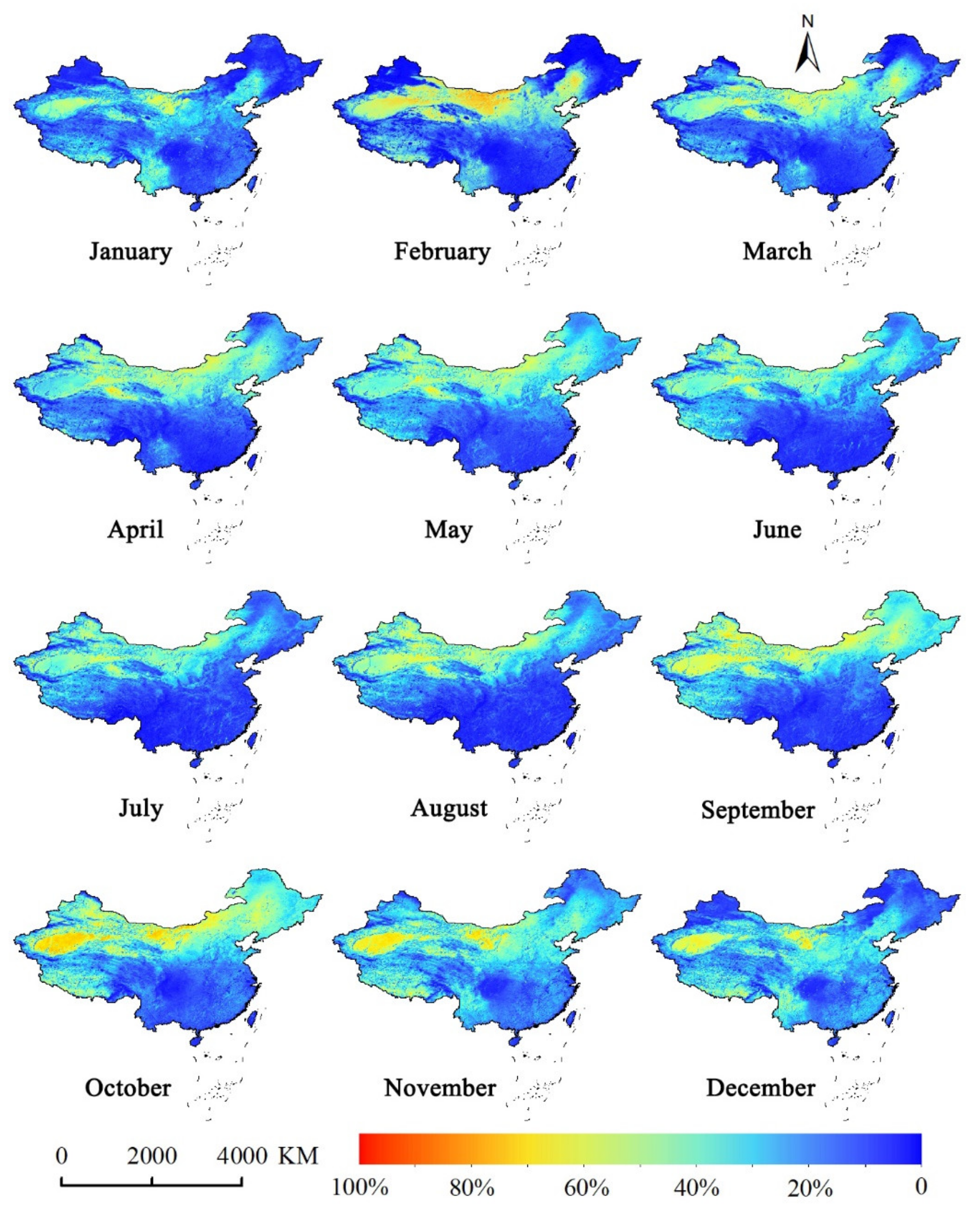
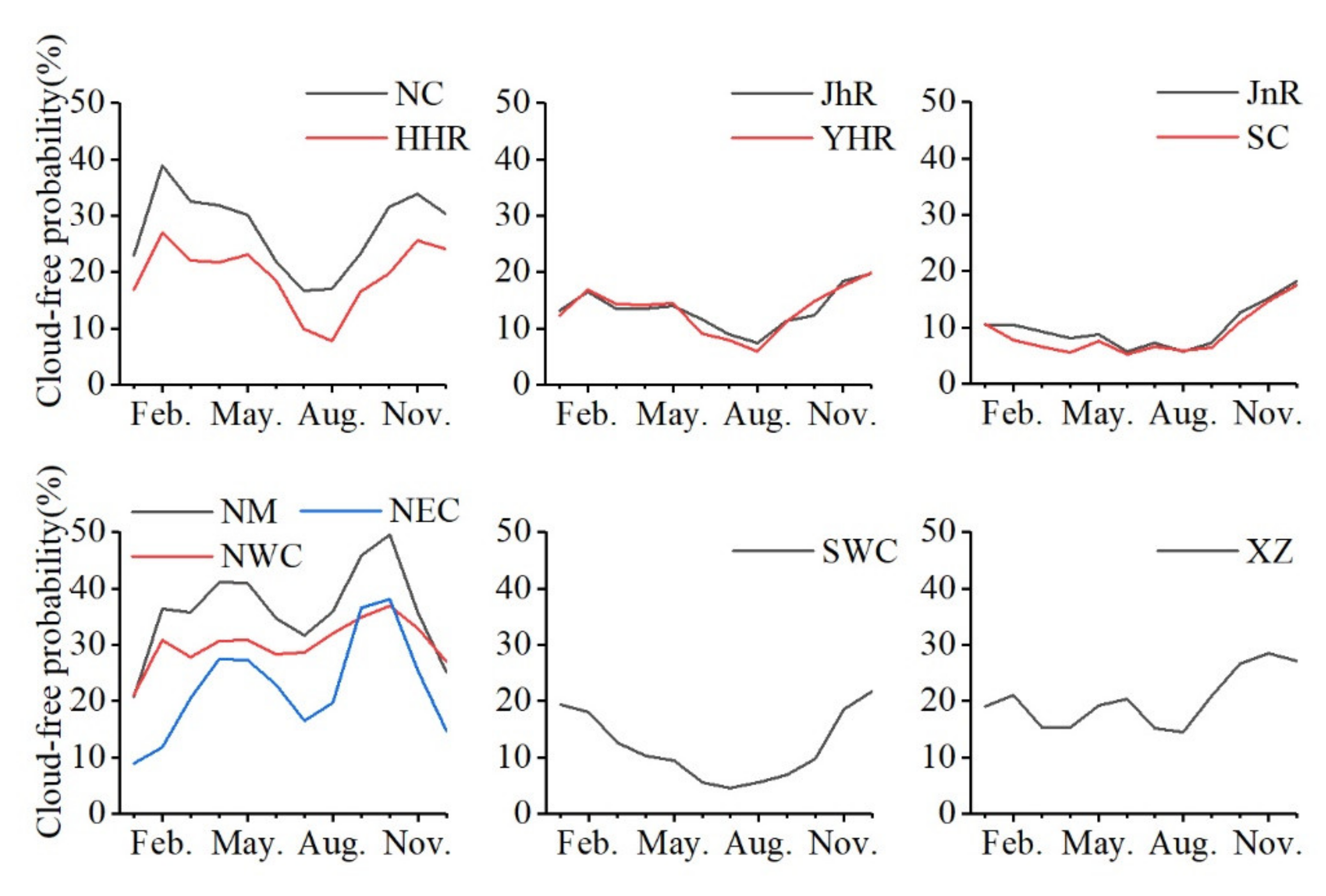

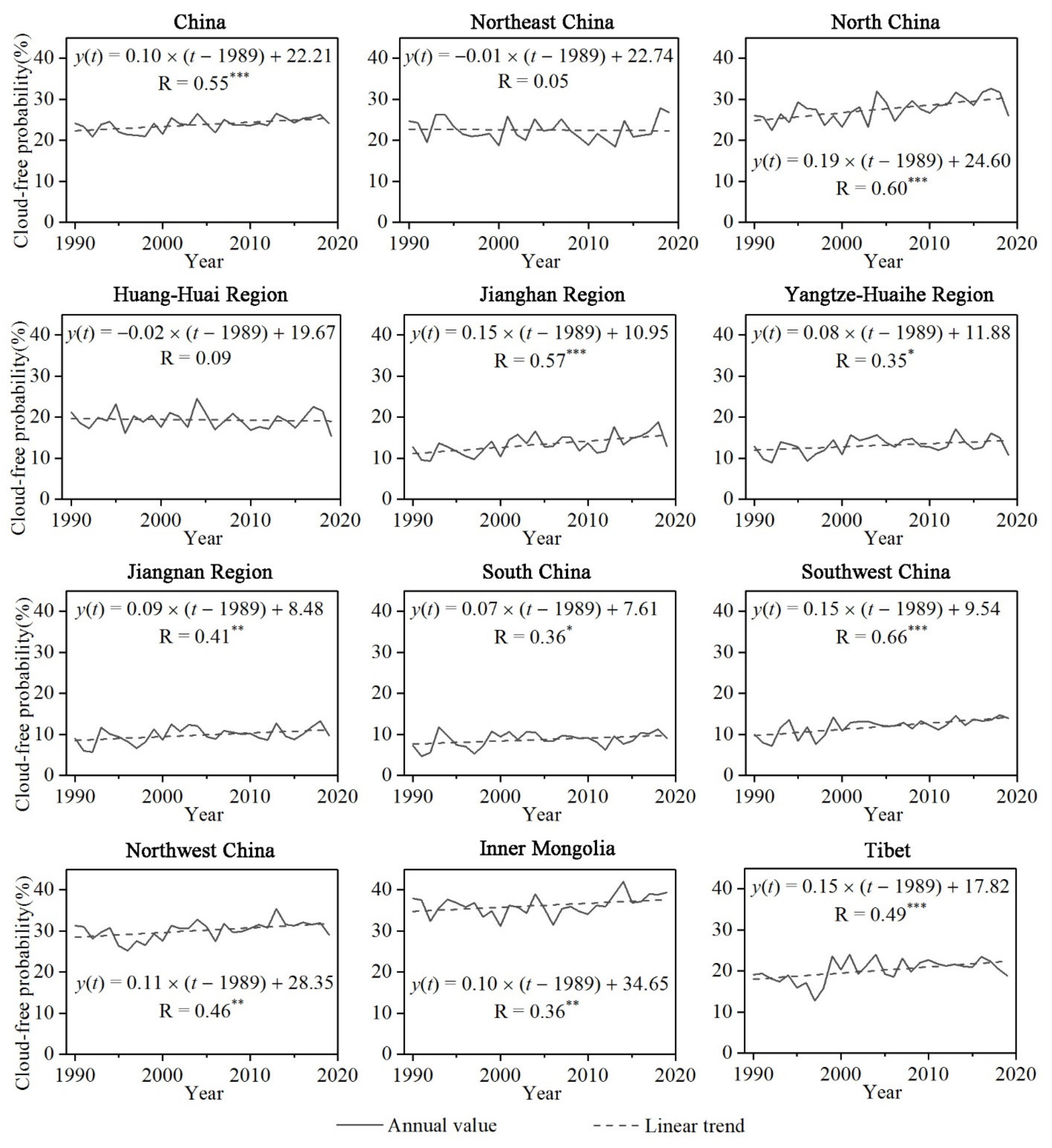
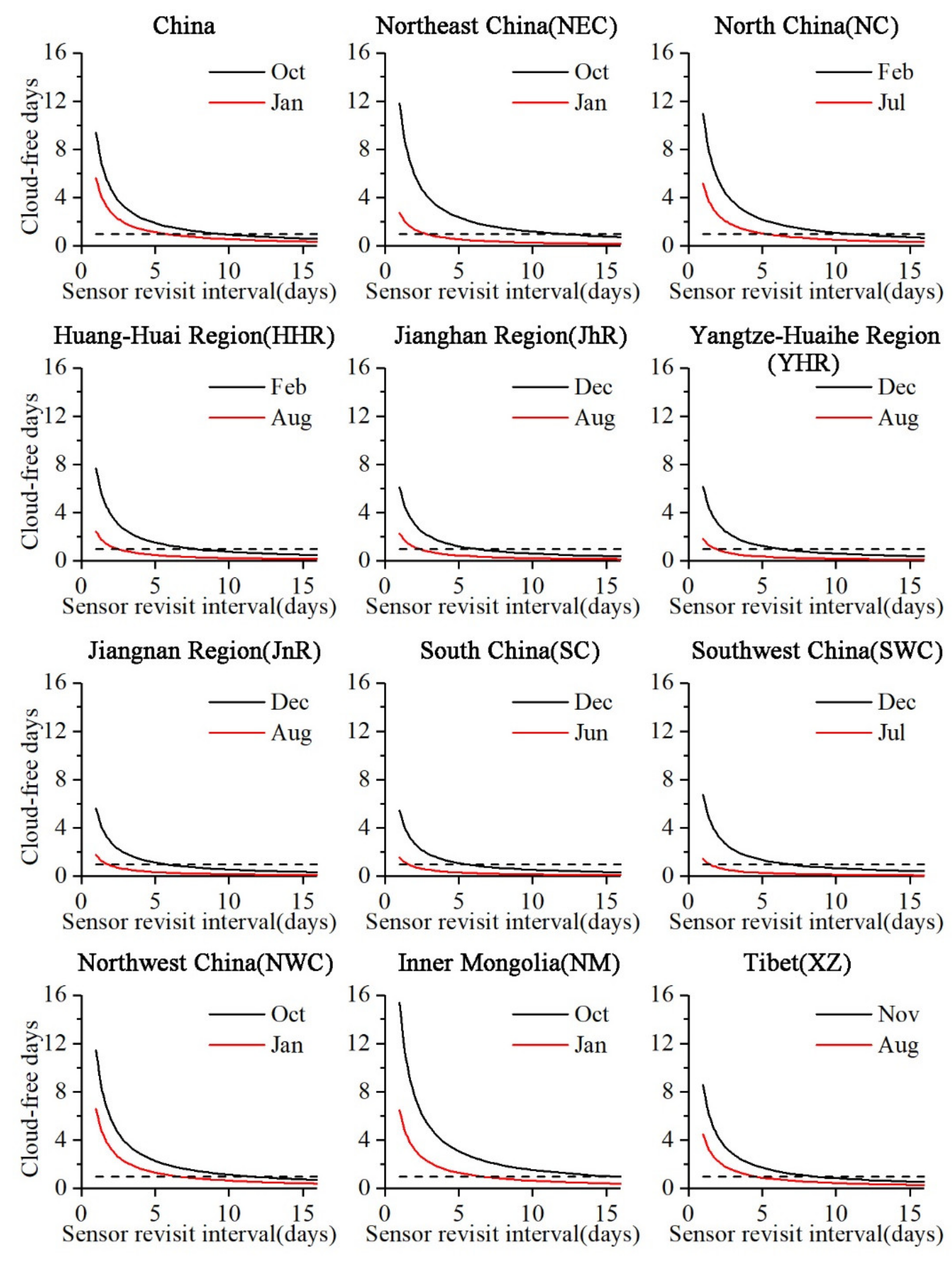
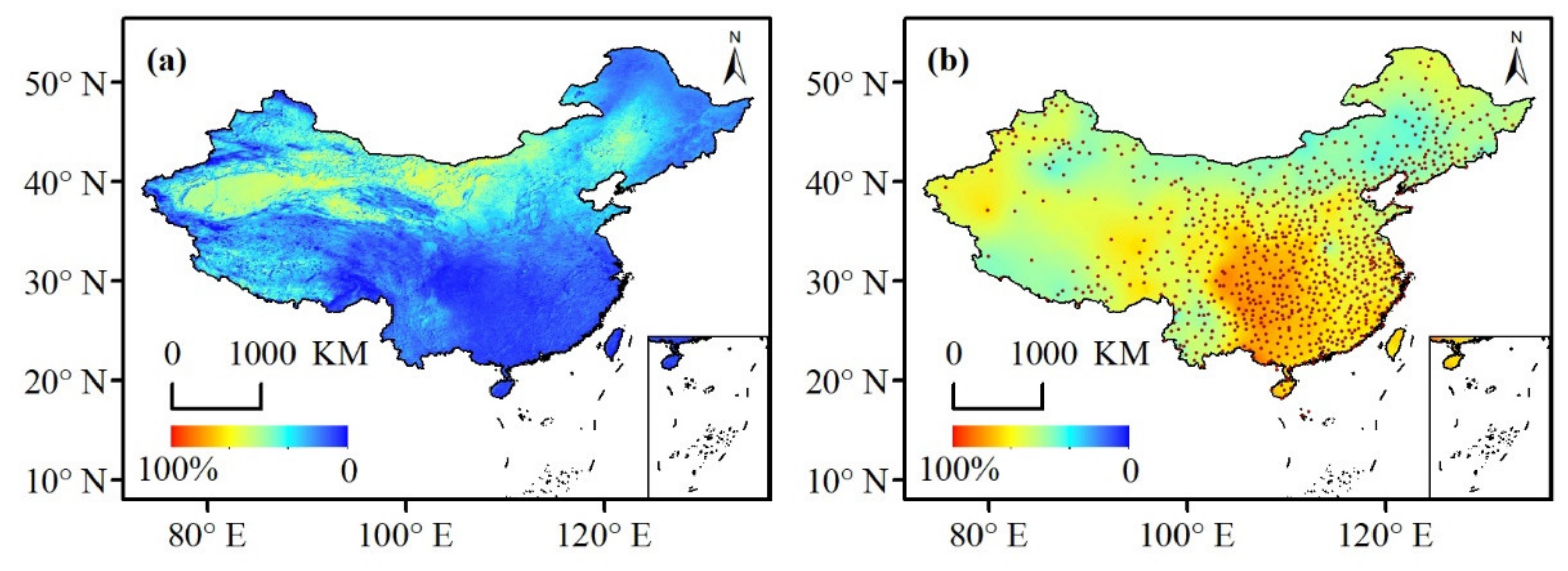
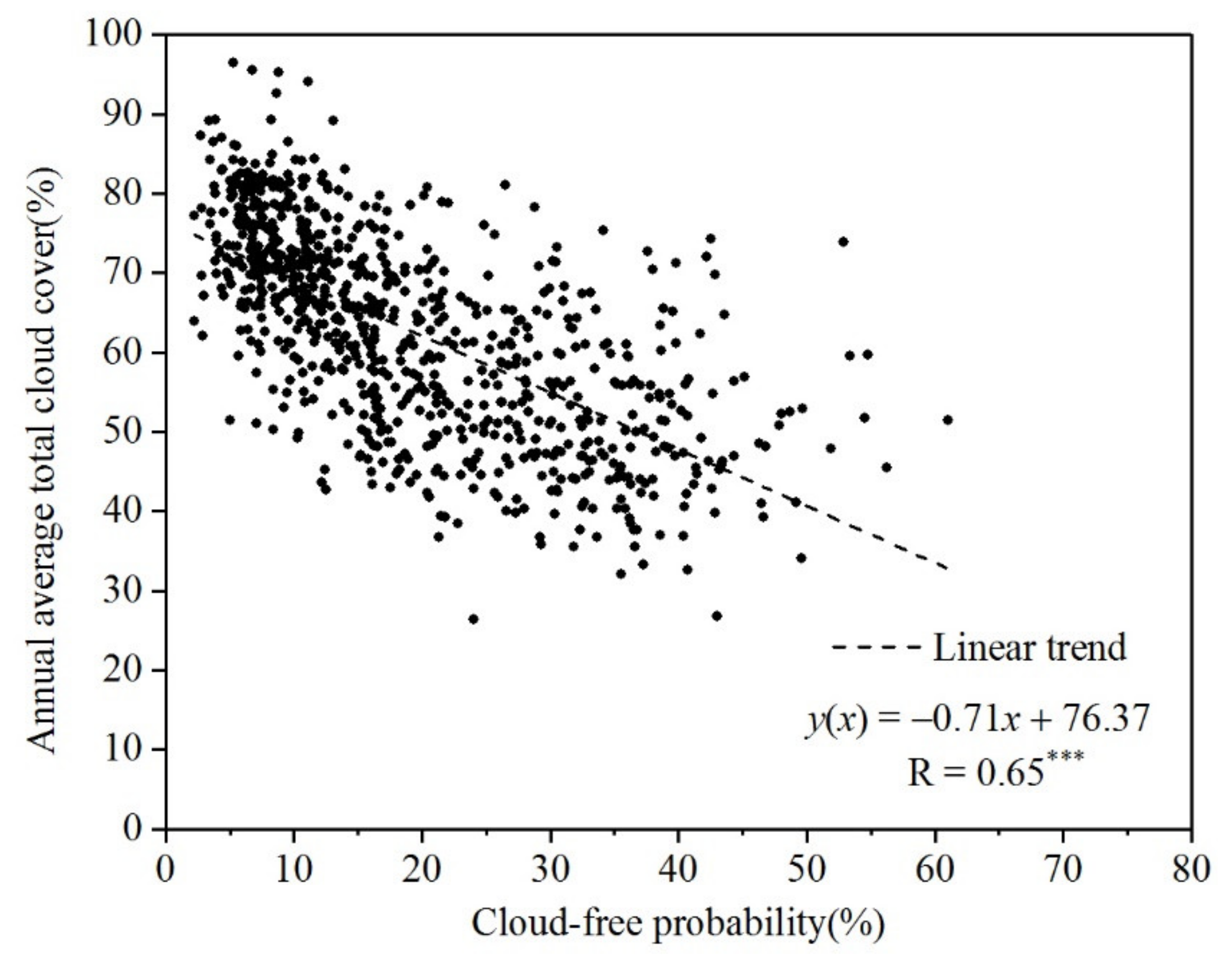
Publisher’s Note: MDPI stays neutral with regard to jurisdictional claims in published maps and institutional affiliations. |
© 2021 by the authors. Licensee MDPI, Basel, Switzerland. This article is an open access article distributed under the terms and conditions of the Creative Commons Attribution (CC BY) license (http://creativecommons.org/licenses/by/4.0/).
Share and Cite
Wu, Y.; Fang, S.; Xu, Y.; Wang, L.; Li, X.; Pei, Z.; Wu, D. Analyzing the Probability of Acquiring Cloud-Free Imagery in China with AVHRR Cloud Mask Data. Atmosphere 2021, 12, 214. https://doi.org/10.3390/atmos12020214
Wu Y, Fang S, Xu Y, Wang L, Li X, Pei Z, Wu D. Analyzing the Probability of Acquiring Cloud-Free Imagery in China with AVHRR Cloud Mask Data. Atmosphere. 2021; 12(2):214. https://doi.org/10.3390/atmos12020214
Chicago/Turabian StyleWu, Yingjie, Shibo Fang, Yi Xu, Lei Wang, Xuan Li, Zhifang Pei, and Dong Wu. 2021. "Analyzing the Probability of Acquiring Cloud-Free Imagery in China with AVHRR Cloud Mask Data" Atmosphere 12, no. 2: 214. https://doi.org/10.3390/atmos12020214
APA StyleWu, Y., Fang, S., Xu, Y., Wang, L., Li, X., Pei, Z., & Wu, D. (2021). Analyzing the Probability of Acquiring Cloud-Free Imagery in China with AVHRR Cloud Mask Data. Atmosphere, 12(2), 214. https://doi.org/10.3390/atmos12020214







